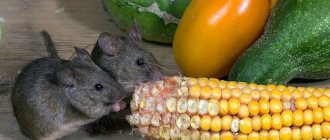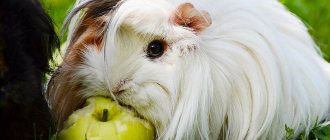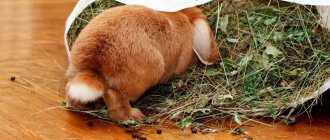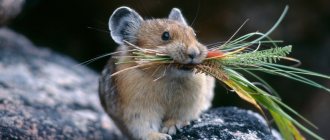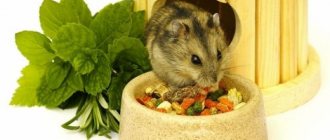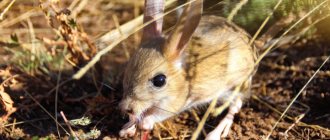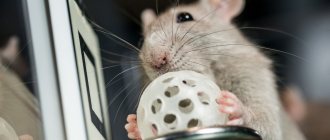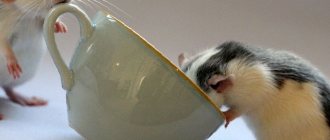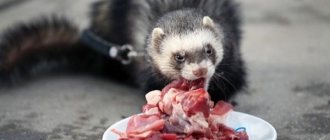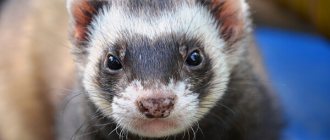Almost every person has acquired a pet at least once in their life. Some prefer common types of pets such as cats and dogs. Some people like exotic reptile species. Well, some owners keep a white mouse as a pet.
has been considered a pet for many years . The origin of these cute animals is controversial. Some sources indicate that the decorative mouse existed before our era. But a more common description of the origin of these mice points to the breeding of ornamental rodent species in laboratories for experiments.
Previously, in many countries there was a belief that if there is a white mouse in the house, it will protect the house from other rodents that can leave the owners without food supplies in a short time. Our ancestors also associated these cute animals with joy. To this day, many people have a favorable attitude towards this decorative animal.
Character and size
in size to its brothers . Their weight is about 30 grams. The length of the body and tail is no more than 11 centimeters.
Absolutely all mice of this species are active. Despite their excessive activity, they are absolutely harmless both to their owners and to other decorative rodents in the house. To have several individuals of this species, the owner does not have to acquire several cells. Mice will live in harmony and agreement even in the same territory, provided that they were placed in a cage of the same age. When a newcomer moves in, the mice will show him with all their appearance that this is their territory and he is clearly a stranger here. Often such settlements end in tears for a new mouse. But this case may be the only act of aggression on the part of ornamental rodents.
In addition to its activity and kindness, the white mouse differs from its relatives in its strong parental love. In addition to the female, the male also takes care of the newborn mouse. This phenomenon is rarely seen among animals.
How to breed decorative mice
Pregnancy in a female lasts no more than 21 days. One litter can have up to 7 mice, weighing about 1.5 grams. Like many newborn animals, children of the decorative rodent are born not only blind and deaf, but also completely bald. After a few days of age, little mice develop a small fluff on their backs. After a week after birth, their bodies are completely covered with hair.
The female feeds the offspring for 4 weeks. But, despite this, already two hours after the female has given birth, she is ready for another fertilization.
Upon reaching the age of one month , decorative mice can take care of themselves without the intervention of their parents. Three months after birth, rodents are able to have offspring themselves.
The average lifespan of rodents is 2-3 years. There have been cases where a white mouse has crossed the threshold at 5 years.
Rodent behavior
Representatives of the mouse family are very smart, inquisitive, agile and capable of reaching speeds of up to 12 km/h. They are brave and, fighting for life, can attack animals many times larger than themselves. To ensure order in the flock, weaker individuals obey the stronger ones. A leader is elected who dominates all members of the pack, and especially young relatives.
Males require more space, allocating only a small area to females. Females in the wild are often aggressive and capable of fighting other predators, but in captivity they have a more friendly and sociable character. They do not show aggression if several other individuals live in their cage.
Male mice living in captivity have a paternal instinct, which makes them very different from mice in the wild.
Animals are most active at night or in the evening. But there are some factors that directly affect the rhythm of activity of small animals:
- Age. Mobility in old rodents is reduced compared to young ones.
- Floor. The female significantly increases her activity before the birth of her offspring. She eats often and a lot, arranges the nest and protects it from other females. And after the birth of a new litter, he remains close to the pups almost all the time, warming and caring for them.
- Features of the structure of the flock and the position of the mouse in it. The activity of subordinate individuals of the pack directly depends on the periods of wakefulness of their leader.
- Change in weather or season. For example, in summer, especially in hot climates, animals become active exclusively at night. This way they are saved from overheating. During daytime temperatures, they can be active even during daylight hours. Mice do not hibernate. During the winter, they do not need to forage for food. Mice living in nature feed on summer supplies.
Where mice live, there are usually plenty of treats for them to covet. Getting out of their homes at night, they steal everything that is in bad shape: seeds, berries and other food products. But during the day they can often be seen on the surface, especially in late August - early September, when the harvest is ripening and you need to stock up on food for the winter.
These animals are very careful. They are quite timid, always listening to all kinds of sounds. If they feel threatened, they hide or run away. They run very fast. The common mouse, as well as representatives of other species, communicate with each other using squeaks. They can live either alone or in small groups. Families unite in the fall to jointly stock up on food for the winter.
READ Laying hens at the dacha important nuances of keeping
Content
In terms of keeping the mouse, it does not require thorough attention and the selection of special food. Plus, the cost of maintaining these pets is quite low .
This decorative rodent from the white mouse family is very easy to train. Once the mouse gets used to its owner, it will not hesitate to come to its owner's arms. When letting a mouse go for a walk from its cage, it is better to keep an eye on it with both eyes. Because if she hides somewhere, then finding her will be a difficult task.
Habitat of a small rodent
The distribution range of mice in natural conditions covers most climatic zones, continents and zones. Representatives of the family can be seen in deciduous and coniferous forests, in tropical thickets, in deserts and steppes, in swampy areas or on mountain slopes. But the most comfortable habitat is human dwellings.
Mice often make nests using grass stems, settle in burrows abandoned by other animals, or dig complex communications under the thickness of the earth. Mountain, forest and steppe varieties of rodents, unlike swamp ones, float rather poorly on water.
House for a decorative mouse
Although these pets are not particularly picky in terms of their maintenance , it is worth knowing some mandatory things regarding housing :
- The cage must be made of metal. The presence of a retractable tray will simplify the process of cleaning the cage and feeding the pet. But when choosing a cage, you should pay attention to the gap between the pallet and the holes. It should be at least 10 centimeters, since if the distance is greater, the mouse will be able to easily crawl into it and its search around the apartment will take a lot of time.
- Requires daily change of litter.
- The cage should be located away from heating devices and drafts.
Some owners believe that an ornamental pet can be placed in an aquarium. This idea is not the best, since glass walls tend to fog up quickly. And cleaning such a home will take much longer than a cage. Even if the owner decides to place his pet in such housing, he should purchase a metal mesh with small holes . This will allow the pet to breathe deeply and protect the owner from escaping his little friend.
What must be present in the cell?
- Small pieces of chalk. If there is a shortage of chalk, then you can place parts from branches in the cage. A rusty piece of bread also works well. These things are necessary for the rodent to sharpen its teeth and to prevent further growth of the incisors and add the necessary minerals to the diet for the healthy growth of the mouse.
- Litter. The most common bedding materials for rodents are paper and sawdust. A good alternative to these materials is hay.
- Wheel. This is perhaps one of the important attributes for the health of a rodent. Due to their activity, mice will not be able to sit still. And it is the running wheel that will remove all the accumulated energy from it.
Dream Interpretation - Bat
Your business will turn out to be dubious and unreliable. So you shouldn’t risk your good name for the sake of an adventure. The least that can happen is that you get into debt. Or it could even lead to a run-in with the law. It's not worth the risk. If you dream of a lot of mice flying around you and trying to attack, you will be “harassed” from all sides, both at work and at home.
And the best thing you can do is not pay attention to the complaints. By the way, a bat is considered a Vampire, a werewolf
It is impossible to imagine the hero of the Hungarian epic Count Dracula without a bat - after all, this animal is one of the faces of the vampire count. In Rus', the bat was believed to be part of the retinue of the devil, witches and sorcerers. It was very often used in various magical rituals. For some peoples, this is a symbol of wisdom and prosperity, and if a bat takes up residence in the attic of a house, it is believed that this is a manifestation of the protection of higher powers.
White mouse food
In order for the pet to be healthy , the owner should remember that the diet must be balanced. The daily consumption rate is 50 grams of food feed. You can use it as food:
- Cereals.
- Vegetables.
- Curd products.
- Grass is a complete source of minerals necessary for the normal functioning of the rodent’s body.
- If the owner decides to use the seeds as feed, then it should be remembered that they must be raw.
- Fertilized and lactating females need fish oil.
- It is advisable to give your pet some raw meat once a week.
- Under no circumstances should mice be fed sweet, salty or fatty foods.
The dosage of food should be optimal . Although rodents live in peace and harmony and are ready to share food with each other, they should not be limited in food. Also, excessive consumption of food will not benefit them.
To summarize, we can say that these peaceful and active animals do not require excessive care when living as a pet. Periodic change of bedding, arrangement of the house and a balanced diet is all that is needed for the healthy growth of a decorative mouse. If you do not neglect these rules, then a happy animal will, without a doubt, thank its owner with love and curiosity, and will become a best friend who will not only be a pet, but also part of the family.
krolla 06/30/201711/24/2019 Category Feeding animalsTags decorative animals, feeding, rats, mice Comment.
Rats and mice are omnivorous animals, so they should not be fed monotonous food of plant origin only. White rats that do not receive enough animal products and the required amount of minerals and vitamins stop growing.
When feeding mice and rats, it is necessary to take into account the extremely high metabolism due to the intensity of growth and development, the high fertility of the mouse family, the short gestation period, the ability to feed their offspring in a very short time and, finally, the small body size. Mice and rats need energy, protein, minerals, vitamins and other biologically active substances. When fed with well-balanced food, they consume on average per head per day: growing mice - 3-5 g and lactating mice - 7-8 g of food, growing rats - 8-20 g and lactating - 30-35 g of food . The energy value of this amount of feed should be 3-3.5 kcal per 1 gram. At the same time, carbohydrates provide 4.1 kcal/g, which should account for up to 50% of the total energy of the diet, protein - 4.1 kcal/g and fats - 9.2 kcal/g.
Based on these data, you can create an approximate diet for rats (see Table 1). If the ratio of essential amino acids is observed, the protein level in the diet of non-lactating animals can be reduced by 15-20%.
Table 1. Approximate diet for rats per day at different periods of their life, g per head
Recipes for briquetted feed have been developed for rats, which contain all the substances they need. Below are two compositions of briquettes recommended by American and German experts, %:
See also: Feeding chinchillas: food, types and diet
1st composition: corn flour - 36.0; wheat flour - 36.0; alfalfa flour - 3.0; flaxseed flour - 10.0; fishmeal - 3.0; liver flour - 1.0; casein - 4.0; table salt - 0.5; milk powder - 4.0; brewer's yeast - 2.0.
2nd composition: corn flour - 25.63; wheat flour - 25.63; fishmeal - 10.00; oat flakes - 25.63; table salt - 1.00; lime carbonate - 1.00; irradiated yeast - 2.00; sodium phosphate - 1.00; potassium iodide - 0.01; manganese sulfate - 0.10; pork liver flour - 5.00.
In the photo: Greater gerbil (their feeding is written in the next article)
The daily food requirement of an adult rat is on average 30-32 g, of which 25 g of mixed food and 5-7 g of vegetables. Pregnant and lactating females are given another 5 g of milk. In this case, you need to ensure that the milk is fresh and not sour. Food must be given in sufficient quantities, as rats do not tolerate starvation well, which can cause cannibalism. Rats are usually fed twice a day. Due to the fact that rats are nocturnal animals, the bulk of their food should be given in the evening. It is not recommended to suddenly change the food regime; you need to switch to new food gradually so that the rats get used to it. It is also impossible to immediately replace water with milk, otherwise the animals will refuse to eat, as their digestion is impaired.
See also: Ready-made feed for amateur rabbit breeders
To feed mice, use the same products and feed as for white rats. An approximate daily diet and norms for feeding white mice are given in Table 2. Like rats, it is more convenient to feed white mice with concentrated combined food made in the form of briquettes. The daily intake of briquettes for white mice is 4-7 g.
Table 2. Approximate daily diet for white mice, g.
Note: the ratio of concentrated feed in the diet is: oats - 50%, millet - 20%, wheat - 10%, barley - 20%. Grain fodder can be replaced with available feed to the full standard.
There is evidence that mice fed briquettes are more fertile and have good immunogenicity. N.V. Kozlyakov (1957) proposed the following composition (in%): wheat flour - 30, oat flour - 35, corn flour - 15, fish meal - 6, dried cow's milk - 6, blood meal - 2, egg powder - 1, fortified fish oil - 1.5, dry yeast - 1.5, ground chalk - 1, table salt - 0.5, food grade Latin - 0.5. The food is then suitable for feeding rats. It is 2.5 times cheaper than feeding regular diets.
The daily food requirement of an adult mouse is on average 9.5-10 g of grain mixture and 1-2 g of vegetables. Pregnant and lactating females are given 2-3 ml of milk.
See also: Feeding breeding rabbits in fur farming
If possible, powdered eggs should be included in the diet of rats and mice and the following products should be used.
Milk is a source of complete proteins, calcium, phosphorus, and vitamins. Raw milk should not be given to animals, only boiled or pasteurized milk.
Wheat is the best grain food for rats and mice. Oats, barley, rye, and millet are somewhat inferior in nutritional properties. Rats and mice readily eat sunflower seeds.
White bread serves as a supplemental food that rats and mice readily eat, especially if it is soaked in milk or sweet tea.
The meat is given boiled; the best are kidneys and liver.
Root vegetables and fresh greens are well eaten by rats and mice, especially chopped beets, carrots, and turnips. For greens, it is good to give these animals lettuce, spinach, cabbage leaves, and in winter - sprouted oats or wheat.
Water must be boiled; the need for it per day is on average 30-32 ml.
In the next article we will talk about feeding hamsters.
If you find an error, please select a piece of text and press Ctrl+Enter.
BraveRobot found more articles on this topic:
- The capital of Iran is attacked by rats the size of cats
- Adorable rat portraits: photographer Diana Ozdamar
- Adorable rat portraits: photographer Diana Ozdamar
- An Australian taught rodents to ride boards - photo
- Sapper rats save Mozambique
- Sapper rats save Mozambique
- How to feed a cat correctly? Basic recommendations
- Creepy giants: the largest rat in the world
- Sea superstitions: Rats
- Honey vitamin elixir: a unique natural composition
Mice: benefits and harm
It's hard to overestimate her. And first of all, it again comes from what the mouse eats. The diet of some species includes insects. By eating them, the rodent rids humanity of harmful and annoying insects, which can often also be carriers of viruses. At the same time, being a delicacy for foxes and owls, they make their existence possible.
The benefit of mice for humanity lies in the fact that these animals are often used in laboratory experiments. Vaccines and medicines are tested on them, which will bring enormous benefits to humanity in the future. In addition, these animals are excellent pets that do not require special care. Even the smallest child can look after pets. Being unpretentious and small, as well as easy to train, they will become favorites for your entire family.
